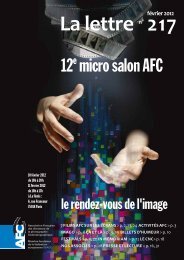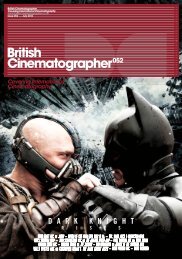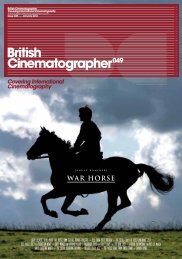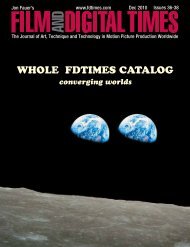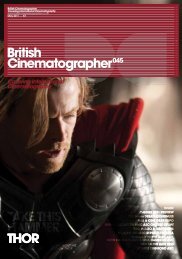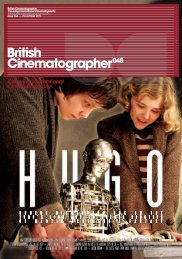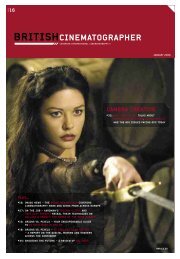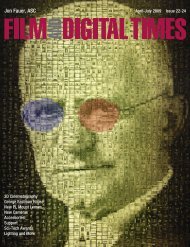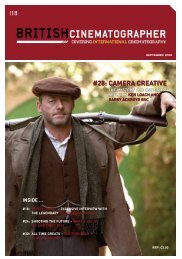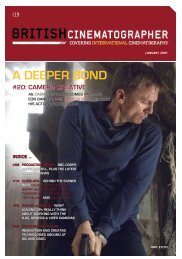British Cinematographer issue 51 - Imago
British Cinematographer issue 51 - Imago
British Cinematographer issue 51 - Imago
Create successful ePaper yourself
Turn your PDF publications into a flip-book with our unique Google optimized e-Paper software.
<strong>British</strong> <strong>Cinematographer</strong><br />
Covering International Cinematography<br />
www.britishcinematographer.co.uk<br />
Issue 0<strong>51</strong> ––– May 2012 36<br />
On the Job<br />
–––Dariusz Wolski ASC<br />
Prometheus 3D<br />
Illuminating... Wolski worked with<br />
gaffer Perry Evans to bring futuristic<br />
LED light to the imagery.<br />
Headshot of Dariusz Wolski<br />
by, and courtesy of, Douglas<br />
Kirkland.<br />
Wolski was born and raised in Warsaw, Poland. He<br />
migrated to New York City in 1979 after graduating from<br />
the national film school at Lodz. Wolski began his career<br />
working on BBC documentaries. He explored new<br />
horizons while shooting commercials and more than 100<br />
music videos, including many for Tony and Ridley Scott’s<br />
company, after moving to Los Angeles in 1986. Wolski<br />
collaborated with Tony Scott on The Crow in 1994 and<br />
Crimson Tide in 1995. He has earned approximately 20<br />
movie credits, including Alice In Wonderland, Rum Diary<br />
and the four popular Pirates Of The Caribbean films.<br />
Scott has earned BAFTA Best Film and Best Director<br />
awards for Thelma And Louise, a Best Director BAFTA<br />
award for Gladiator, a Best Film BAFTA Award for<br />
American Gangster and Academy-Award nominations<br />
for Thelma And Louise, Gladiator and Black Hawk Down.<br />
A short list of his other memorable credits includes Alien,<br />
Blade Runner, Robin Hood, Someone To Watch Over<br />
Me, Hannibal, Body Of Lies and American Gangster. Sir<br />
Ridley Scott was knighted in 2003 in recognition of his<br />
contributions to advancing the art of filmmaking.<br />
“Ridley visited the set in Los Angeles whilst I was<br />
shooting Pirates Of The Caribbean: On Stranger Tides in<br />
3D stereo format in 2009,” Wolski recalls. “Later, he visited<br />
the set while we were shooting in London and began a<br />
conversation about producing Prometheus in 3D.”<br />
Although the RED Epic camera was still in the<br />
prototype stage at this time, Wolski says that he and<br />
Scott were interested, because it is half the size of<br />
other digital cameras and has a 5K chip. After Wolski<br />
completed production of Pirates, they shot a 3D test with<br />
a prototype Epic camera and agreed it was the right<br />
tool for producing Prometheus.<br />
“I think Ridley is a genius,” Wolski says. “His body of<br />
work is incredible. He has pioneered the contemporary<br />
science fiction genre. He created kind of grungy,<br />
textural looks for Alien and Blade Runner that were<br />
complete departures from other science fiction movies.<br />
I knew from watching his films over the years that he is<br />
always driven to take it to the next level.”<br />
The script for Prometheus is an original story coauthored<br />
by Jon Spaihts and Damon Lindelof. A short<br />
list of the ensemble cast includes Charlize Theron, Guy<br />
Pearce, Noami Rapance and Michael Fassbender.<br />
“Ridley envisioned a very sterile, clean look with a<br />
little bit of texture,” Wolski says. But how much is a little bit?<br />
Every filmmaker has a different answer to that question.<br />
Most of Prometheus was produced on stages at<br />
Pinewood Studios with additional scenes shot on the<br />
backlot. Wolski credits production designer Arthur Max<br />
and set decorator Sonia Klaus with playing significant<br />
roles in providing believable environments for both the<br />
spaceship and the alien planet. Background plates<br />
and exterior scenes on the planet were produced at<br />
a national park in Iceland. Aerial shots of mountains in<br />
Jordan were taken from a helicopter. They also shot one<br />
scene in the mountains in Scotland.<br />
“I knew that Ridley likes to be able to move fast with<br />
cameras,” Wolski says. “After we decided to go with RED<br />
Epic cameras, we told the people who we were dealing<br />
with them how to make the stereo rig simpler, smaller<br />
and more flexible.”<br />
37<br />
<strong>British</strong> <strong>Cinematographer</strong><br />
Covering International Cinematography<br />
www.britishcinematographer.co.uk<br />
Issue 0<strong>51</strong> ––– May 2012<br />
Most of the story takes place on the spaceship and<br />
underground on the planet. “They are very big spaces,<br />
which I lit as minimally as possible,” Wolski says. “The<br />
characters are wearing helmets with lamps on them, so<br />
there was light on their faces. They also carried flashlights<br />
everywhere. (Gaffer) Perry Evans designed futuristiclooking<br />
light fixtures on spaceship sets, using LED lights that<br />
were controlled with dimmers. It’s very naturalistic looking<br />
and it gave us the freedom to put cameras anywhere.”<br />
Wolski’s crew included Steadicam operator Daniele<br />
Massaccesi, who came from Italy, camera operators<br />
Graham Hall and Gary Spratling, first assistants John<br />
Fergurson, Robert Palmer, Miles Proudfoot, second<br />
assistants David Churchyard, Elliot Dupuy, Iain Mackay<br />
and Paul Wheeldon. Perry Evans was the gaffer, Gary<br />
Hyams was the key grip, Adrian Barry was the grip and<br />
Adam Dale was the aerial cinematographer.<br />
“My crew were terrific,” he says. “The camera<br />
operators and assistants were put into very complex<br />
situations, where they had to adapt quickly. They all did<br />
great jobs.”<br />
A number of people on his crew had collaborated<br />
with Wolski on Pirates Of The Carribean: On Stranger<br />
Tides, including stereographer James Goldman. Wolski<br />
explains that the stereographer is the person who<br />
watched his back while he was lining up shots.<br />
“There are two principles,” he says. “You have to<br />
be careful about the interocular distance between the<br />
eyes and the point of convergence. On Pirates Of The<br />
Carribean: On Stranger Tides, we weren’t converging<br />
on the set. We were shooting parallel takes and doing<br />
convergence during postproduction, when we decided<br />
how deep backgrounds should be.”<br />
O U T E R S P A C E<br />
Prometheus takes the audience<br />
on a 3D journey to a planet in<br />
outer space with a group of<br />
explorers who are on a quest to<br />
find the secret to the origins of life<br />
on Earth. The spaceship is named<br />
after Prometheus who, in Greek<br />
mythology, stole fire from Zeus and<br />
gave it to mortals. Dariusz Wolski<br />
ASC and Ridley Scott brought<br />
deep pools of experience and<br />
talent for the global art of visual<br />
storytelling to this ambitious<br />
endeavour, writes Bob Fisher.<br />
Wolski explains that each stereo rig held two RED<br />
Epic cameras at 90 degree angles with a mirror used<br />
to emulate the way people see 3D with their eyes.<br />
The interocular distance was controlled by motors<br />
and the alignment was monitored with a control box<br />
where Wolski and his crew could see if the images were<br />
properly aligned. Images were composed in widescreen<br />
in 2.4:1 ratio.<br />
Wolski says that the Epic camera has a comfortable<br />
800 exposure index. However, they were losing almost<br />
a stop, because they were shooting in 3D stereo with a<br />
mirror rig. He always had cameras on four rigs ready to<br />
roll at all times. Wolski explains that it would have taken<br />
too long to change and realign two shorter and longer<br />
prime lenses with the mirror. The cameras on two rigs had<br />
Angenieux 16-40mm short zoom lenses on them. The<br />
cameras on the other two rigs had longer Angenieux<br />
27-76 mm zoom lenses on them.<br />
Wolski says that he dealt with the actors and<br />
everyone else the same way the same way he would<br />
on a 2D movie. “We had to be careful of eye lines and<br />
two cameras are obviously heavier than one, but that<br />
didn’t stop us from putting them on a Steadicam,” he<br />
says. “The best tool was the Technocrane, because we<br />
could put it everywhere. When the cameras were set,<br />
the stereographer and rig technicians made sure all the<br />
zoom lenses were properly aligned.”<br />
Because they were shooting with multiple cameras,<br />
the production had an extensive video village. There<br />
was a director’s tent with two big 3D monitors inside, and<br />
also two high-end 2D monitors that Wolski could switch<br />
between the left and right eye cameras.<br />
“I was monitoring individual eyes and also looking at<br />
2D images on big monitors,” he explains. “It was a very<br />
complex video village that required special wiring with<br />
great video playback. We rehearsed with it on Pirates<br />
and improved it tremendously on Prometheus.<br />
“The tent was always near the set. Ridley spoke with<br />
the actors when they came on the set. He set everything<br />
up and then went back into the tent. I was constantly<br />
moving between the village and the set.” When the<br />
production shot in Iceland the video village was housed<br />
in a truck due to the wind and cold weather.<br />
“We created data files which were a little bit more<br />
compressed for dailies and watched them on a big<br />
television screen,” Wolski says. “In the beginning, we<br />
watched a lot of dailies on the big screen to make sure<br />
that the look was what we envisioned. I timed dailies on<br />
the set by downloading files and touching up shadows<br />
and colour temperatures. You can play with it.<br />
“Most of the look, including convergence of images<br />
from two cameras, was created while we were timing<br />
dailies for the 3D release,” Wolski says. “We played a bit<br />
with shadows and colours in DI. A lot of nuances were<br />
added when we timed the 2D version.”<br />
The digital intermediate was timed in collaboration<br />
with colorist Stefan Nakamura at Company 3 in Santa<br />
Monica. There is also going to be a 2D release in IMAX<br />
format.<br />
Wolski offers the following advice for<br />
cinematographers who are shooting their first 3D<br />
movie: “Trust your instincts the way you would if you<br />
were shooting in 2D format. There are people who are<br />
extremely knowledgeable about 3D, but they have<br />
very little experience dealing with a cast and crew and<br />
the unexpected things that can happen when you are<br />
shooting a film. My best advice is try to shoot it like a<br />
normal film. One of the big differences is that you have<br />
to light and compose images for three-dimensional<br />
viewing. You don’t want it to look flat.”<br />
Twentieth Century-Fox is releasing Prometheus in<br />
both 3-D and 2-D IMAX formats.



